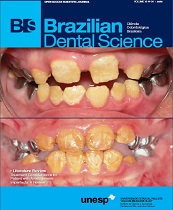Cuspal deflection of directly or indirectly restored teeth
DOI:
https://doi.org/10.14295/bds.2013.v16i4.899Resumo
Objective: The aim of this study was to evaluatethe cuspal deflection of teeth restored directlyand indirectly. Material and Methods: Fortysound maxillary premolar teeth were restoredwith composite and different base materials. Widemesial-occlusal-distal cavity preparations wereperformed, with isthmus width of one third of thedistance between the cuspal tips, 3 mm occlusaland a 5 mm interproximal preparation height. Theteeth were divided into 4 groups (n = 10), accordingto the restoration type: G1) GIC-DCR (1 mm glassionomer cement base and direct restoration usingnanoparticulate composite); G2) FL-DCR (1 mm baseof flowable composite resin and direct restorationusing nanoparticulate composite); G3) GIC-ICR(1 mm glass ionomer cement base and indirectrestoration using nanoparticulate composite GICbase); G4) FL-ICR (1 mm base of flowable compositeresin and indirect restoration using nanoparticulatecomposite). The specimens were submitted tocompressive load of 50 N on the buccal and lingualcusps, in a universal testing machine. The lingualcusp microstrain (??) measurements were executedby strain gauges. Results: The Kruskal-Wallis (5%)test was used and showed there were no significantdifferences among the microstrain values for the fourstudy groups (G1 = 1250; G2 = 1075; G3 = 1279;G4 = 937). Conclusion: It could be concluded thatthe restorative techniques and the bases employeddid not show any influences in cuspal deflection.
Keywords
Base materials; Cuspal defection; Composite resin; Direct restoration; Indirect restoration.
Downloads
Downloads
Publicado
Como Citar
Edição
Seção
Licença
TRANSFERÊNCIA DE DIREITOS AUTORAIS E DECLARAÇÃO DE RESPONSABILIDADE
Toda a propriedade de direitos autorais do artigo "____________________________________________________________________" é transferido do autor(es) para a CIÊNCIA ODONTOLÓGICA BRASILEIRA, no caso do trabalho ser publicado. O artigo não foi publicado em outro lugar e não foi submetido simultaneamente para publicação em outra revista.
Vimos por meio deste, atestar que trabalho é original e não apresenta dados manipulados, fraude ou plágio. Fizemos contribuição científica significativa para o estudo e estamos cientes dos dados apresentados e de acordo com a versão final do artigo. Assumimos total responsabilidade pelos aspectos éticos do estudo.
Este texto deve ser impresso e assinado por todos os autores. A versão digitalizada deverá ser apresentada como arquivo suplementar durante o processo de submissão.




























